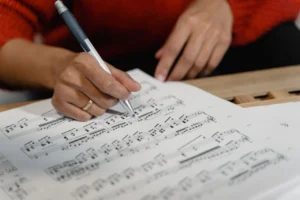The clarinet captivates musicians with its versatility and rich sound. It shines across genres, from classical to jazz, thanks to its unique tonal quality. Many beginners choose the clarinet because its learning curve feels manageable, making the joy of creating music more accessible. If you’re eager to learn clarinet, you’ll find the process both rewarding and enjoyable.
This guide introduces clarinet fundamentals to kickstart your journey. You’ll discover its different parts and essential techniques to help you produce beautiful notes. By the end, you’ll feel excited and ready to start playing the clarinet. Let’s embark on this musical adventure together!
What is the Clarinet?
Definition of the Clarinet
The clarinet produces sound through a single-reed mouthpiece, offering a wide range of notes and dynamic expression. Its unique design makes it popular across various musical genres.
Materials of Construction
One key characteristic of the clarinet lies in its construction. Traditionally crafted from wood, it produces a warm, rich sound. However, many beginner models feature plastic, which offers greater durability and easier maintenance. This material impacts the instrument’s tone, with wood delivering deeper resonance compared to plastic.
Differences with Other Wind Instruments
When comparing the clarinet to other wind instruments, distinct differences stand out. The saxophone, another single-reed instrument, offers a more robust and brighter sound. In contrast, the flute, made of metal or plastic and without a reed, produces a completely different tonal quality. Meanwhile, the trumpet, a brass instrument, uses valves and a unique playing technique to create its sound.
Types of Clarinets
Various types of clarinets suit different musical styles and ranges. The most common is the soprano clarinet, frequently used in orchestras and bands. Other types include the bass clarinet, which plays in a lower register, and the contrabass clarinet, known for its deep tones. Each type adds to the instrument’s versatility, making the clarinet a fascinating choice for musicians.

Parts of the Clarinet
Mouthpiece:
The mouthpiece, where you blow air to produce sound, plays a crucial role in the clarinet. It holds a single reed that vibrates as you blow into it. The shape and material of the mouthpiece significantly impact sound quality. A well-designed mouthpiece provides better control and a richer tone, making it essential for both beginners and advanced players.
Body:
The body of the clarinet is made up of several sections, usually crafted from wood or plastic. Each section plays a role in shaping the overall sound. The upper and lower joints connect to the barrel and the bell. The quality of the materials directly affects the tone and resonance, with higher-quality wood producing a warmer and more complex sound.
Keys and Pads:
The clarinet features numerous keys that control different notes by covering specific holes on the body. Felt and leather pads seal these holes when a key is pressed, ensuring proper sound. Well-functioning keys and pads are crucial for smooth playing and accurate note production.
Bell:
The bell, located at the flared end of the clarinet, plays a vital role in projecting sound. Its design influences the instrument’s volume and tonal quality. A well-shaped bell enhances sound clarity and richness, allowing the clarinet to fill a room with music effectively.
Main Musical Styles
Classical Music:
In classical music, the clarinet plays a vital role in orchestras and chamber ensembles. Composers such as Mozart and Brahms highlighted its expressive capabilities, using it to create rich melodies and harmonies.
Jazz:
The clarinet shines in jazz music, where it brings a unique style and technique. Notable jazz clarinetists like Benny Goodman and Sidney Bechet utilized improvisation, showcasing the instrument’s versatility and vibrant sound.
Folk Music:
In folk music, the clarinet plays a prominent role in various cultural traditions around the world. If you learn clarinet, you can appreciate how it adds distinctive tones to celebrations and storytelling, enriching the overall sound and atmosphere.
Contemporary Music:
Contemporary composers are exploring new trends and techniques for the clarinet. They experiment with innovative uses of the instrument in modern compositions, pushing the boundaries of traditional playing styles and expanding their repertoire.
Tips for Learning to Play the Clarinet
Establish a Practice Routine:
Consistency is crucial for mastering the clarinet. Set aside time each day to practice. This habit helps build muscle memory and improves your skills over time.
Breathing Techniques:
Proper breathing significantly enhances sound quality. Focus on diaphragmatic breathing to support your notes. Take deep breaths, and remember to exhale steadily while playing.
Study Sheet Music:
Improving your musical reading skills boosts your overall performance. Start with simple pieces and gradually move to more complex scores. This approach sharpens your ear and deepens your understanding of music.
Listen to Other Clarinetists:
Gain inspiration by listening to experienced clarinet players. Pay close attention to their techniques and styles. Observing how they approach the instrument can teach you valuable lessons.
Have Fun While Learning:
Keeping your practice enjoyable is key when you learn clarinet. Explore different songs and genres that excite you. Celebrate small achievements along the way to maintain your motivation and continue your progress.
Focus on Embouchure
A correct embouchure is key to producing a good sound. Experiment with your mouth position and make adjustments until you find what works best for you.
Practice Scales and Simple Melodies:
Regularly practicing scales strengthens your finger technique. Start with basic scales and simple melodies, gradually increasing complexity as you improve.
Seek a Professional Teacher:
If you’re seeking a skilled clarinet teacher in Dubai, look for a professional who can guide you to learn clarinet effectively. A good teacher offers personalized feedback and helps you progress more quickly.




